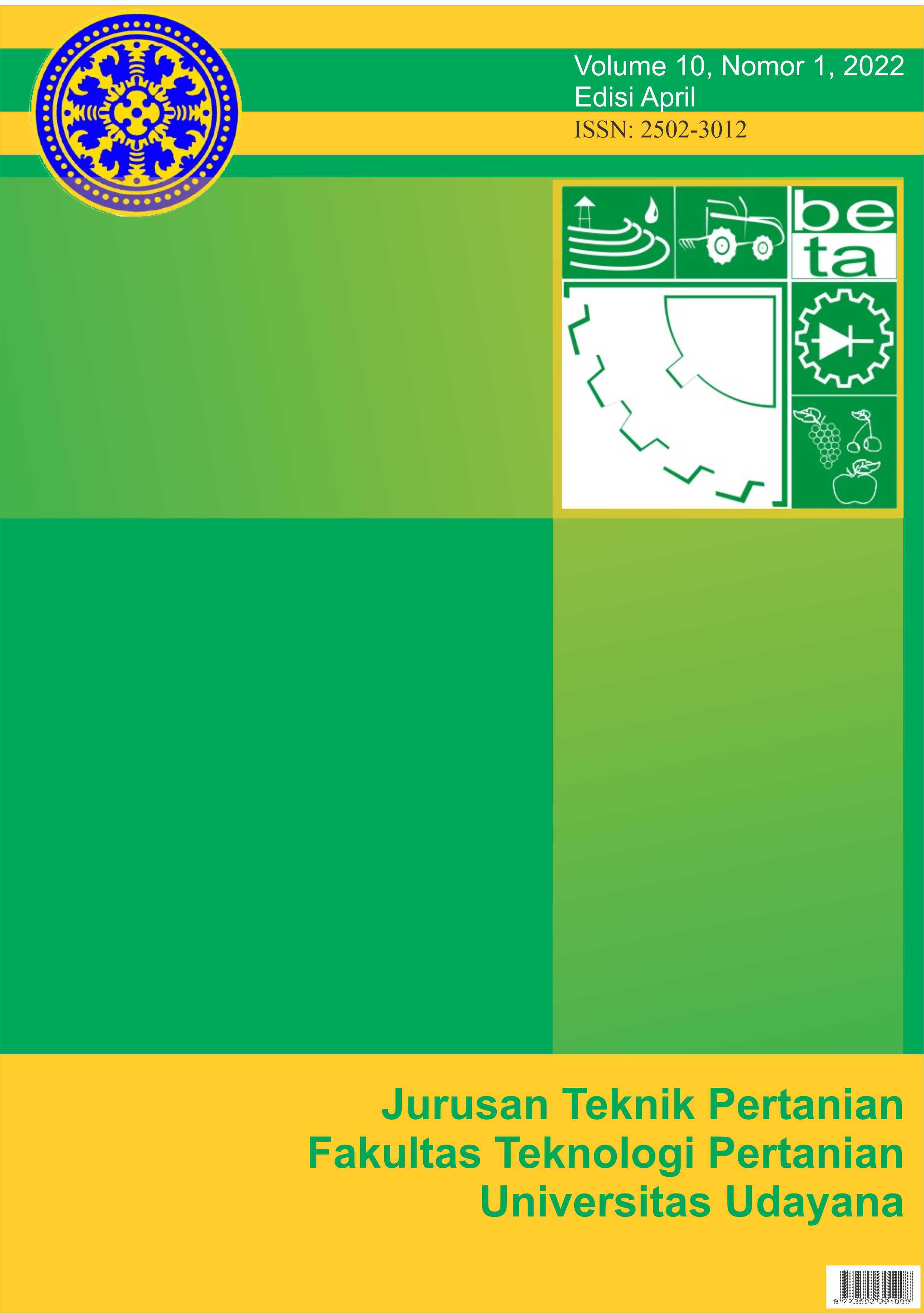Rancang Bangun Sistem Pencampuran Nutrisi pada Fertigasi untuk Hidroponik Berbasis IoT (Internet of Things)
Abstract
ABSTRAK
Perkembangan IoT (Internet of Things) dalam upaya menyatukan dunia nyata, dunia cyber, dan dunia sosial juga telah dimanfaatkan pada sektor pertanian salah satunya pada pertanian dengan sistem hidroponik. Kebutuhan nutrisi yang tepat membutuhkan suatu sistem yang dapat membantu petani dalam memberikan nutrisi yang tepat didukung oleh perkembangan teknologi dengan bantuan sensor untuk mengukur konsentrasi nutrisi pada tangki utama. Penelitian ini bertujuan untuk merancang bangun sistem pencampuran nutrisi pada fertigasi untuk hidroponik berbasis IoT (Internet of Things), yaitu sistem yang dapat memberikan nutrisi berupa pupuk AB Mix terlarut sesuai dengan kebutuhan petani secara jarak jauh melalui jaringan internet. Rancang bangun sistem yang dihasilkan pada penelitian ini meliputi penggunaan Arduino Mega 2560 R3 sebagai mikrokontroler yang terhubung dengan sensor DS18B20 sebagai pengukur suhu, sensor Keyestudio KS0429 sebagai pengukur konsentrasi nutrisi, relay sebagai pengendali aplikator, LCD 16x2 sebagai penampil data, NodeMCU Lolin V3 sebagai pengirim dan penerima data pada Google Firebase (server database) melalui internet pada jaringan WiFi (Wireless Fidelity), serta perangkat lunak user interface pada smartphone dengan OS Android yang berfungsi sebagai media antar muka untuk petani dalam memantau konsentrasi nutrisi dan menentukan nilai set point yang diinginkan. Sistem yang dirancang menghasilkan prototipe yang telah berhasil membaca, mengirim, menerima, dan menyimpan data dengan koneksi internet yang sangat baik pada jaringan WiFi, hasil uji sensor DS18B20 dengan tingkat korelasi yang kuat sebesar 0.89 dan sensor Keyestudio KS0429 sebesar 0.8 dengan metode Pearson, serta hasil uji prototipe keseluruhan dengan nilai RMSE (Root Mean Square Error) sebesar 0.08 serta efisiensi waktu dalam pemberian nutrisi sebesar 77.77%.
ABSTRACT
The development of IoT (Internet of Things) is an effort to unite the real world, the cyber world, and the social world has also been used in the agricultural sector, such as in the hydroponic system. Proper nutrition requires a system that can assist farmers in providing the correct nutrients concentration supported by technological developments with the help of sensors to measure them in the main tank. The purpose of this research is to develop an IoT-based nutrient mixing system for hydroponic fertigation, that can provide nutrients in the form of dissolved AB Mix fertilizer according to the farmer's needs via the internet remotely. The design in this research includes the use of Arduino Mega 2560 R3 as a microcontroller which is connected to the DS18B20 sensor as a temperature sensor, Keyestudio KS0429 sensors to measure nutrient concentration, relay as an applicator controller, the 16x2 LCD as a data display, NodeMCU Lolin V3 as a sender and data receiver on Google Firebase (database server) via the internet on a WiFi (Wireless Fidelity) network, as well as the user interface software for Android OS smartphone that can be used by farmers to monitor the nutrient concentrations and determine the desired setpoint value. The system has successfully read, sent, received, and stored data with a fast internet connection over a WiFi network, the test result of the DS18B20 sensor with a strong correlation level of 0.89 and the Keyestudio KS0429 sensor of 0.8 with the Pearson method, and the result of overall prototype test with RMSE (Root Mean Square Error) value of 0.08 and time efficiency in providing nutrition is 77.77%.
Downloads
References
Bugbee, B. 2004. Nutrient Management in Recirculating Hydroponic Culture. Acta Horticulturae, 99–112.
Eridani, D., Wardhani, O., & Widianto, E. D. 2017. Designing and Implementing The Arduino-based Nutrition Feeding Automation System of a Prototype Scaled Nutrient Film technique (NFT) Hydroponics Using Total Dissolved Solids (TDS) Sensor. Proceedings - 2017 4th International Conference on Information Technology, Computer, and Electrical Engineering, ICITACEE 2017, 170–175. https://doi.org/10.1109/ICITACEE.2017.8257697
Hahn, F. F., & González, F. 2013. Automatic Dosing of Fertigation Solution Tanks. American Society of Agricultural and Biological Engineers, 6, 4889–4894.
Hesham, Z., A., H., & M., M. 2015. Internet of Things (IoT): Definitions, Challenges and Recent Research Directions. International Journal of Computer Applications, 128(1), 37–47. https://doi.org/10.5120/ijca2015906430
Jensen, M. H. 1997. Hydroponics. In HortScience (Vol. 32, Issue 6, pp. 1018–1021). https://doi.org/10.21273/hortsci.32.6.1018
Junaidi, A. 2015. Internet of Things, Sejarah, Teknologi Dan Penerapannya : Review. Jurnal Ilmiah Teknologi Informasi Terapan, I(3), 62–66.
Kelley, K., & Lai, K. 2011. Accuracy in Parameter Estimation for The Root Mean Square Error of Approximation: Sample Size Planning for Narrow Confidence Intervals. Multivariate Behavioral Research, 46(1), 1–32. https://doi.org/10.1080/00273171.2011.543027
Nowak, J. T. 1977. Influence of Increased Doses of Microelements in Hydroponic Nutrient Solution on The Yield of Capsicum annuum L. Fruits and Their Capsaicin Content. ACTA AGROBOTANICA, 33(1), 73–80.
Sembiring, G., & Maghfoer, M. 2018. Pengaruh Komposisi Nutrisi Dan Pupuk Daun Pada Pertumbuhan Dan Hasil Tanaman Pakcoy (Brassica Rapa L.Var. Chinensis) Sistem Hidroponik Rakit Apung. PLANTROPICA Journal of Agricultural Science, 3(2), 103–109.
Suarjana, I., Aviantara, G., & Arda, G. 2020. Pengaruh Jarak Tanam Terhadap Pertumbuhan dan Hasil Tanaman Bayam (Ammaranthus tricolor) Secara Hidroponik NFT (Nutrient FIlm Te. Jurnal BETA (Biosistem Dan Teknik Pertanian).
Sugiyanto, E. 2020. Teknologi Smart Farming- Pentingnya Pendidikan Petani Hari ini & di Masa Mendatang (Issue November, pp. 1–29). Webinar Series Hydroponic Workshop.
Susilawati, Suwignyo, R. A., Munandar, & Hasmeda, M. 2012. Irigasi Tetes pada Budidaya Cabai. In Jurnal Agronomi Indonesia (Vol. 40, Issue 3).
Tufik, C. B. A., Fontes, P. C. R., Milagres, C. do C., & Moreira, M. A. 2019. Productivity of Potato Seed Submitted to Different Doses of Potassium in Hydroponic System. Emirates Journal of Food and Agriculture, 31(7), 555–560. https://doi.org/10.9755/ejfa.2019.v31.i7.1979
Widodo, & Stiyawan, E. A. 2020. Design of Total Dissolve Solid (TDS) Measuring Using Conductivity Sensor and Temperature Sensor DS18B20. BEST : Journal of Applied Electrical, Science, & Technology, 2(1), 25–29. https://doi.org/10.36456/best.vol2.no1.2583












 Jurnal BETA (Biosistem dan Teknik Pertanian)
Jurnal BETA (Biosistem dan Teknik Pertanian)


